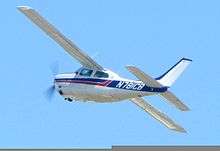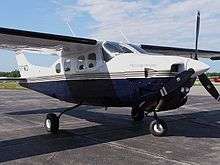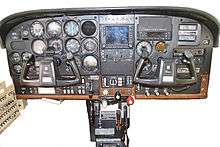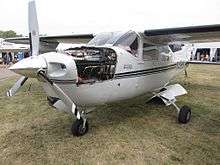Cessna 210
| Model 210 Centurion | |
|---|---|
 | |
| A Cessna 210 Centurion | |
| Role | Light aircraft |
| National origin | United States |
| Manufacturer | Cessna |
| First flight | January 1957[1] |
| Introduction | 1957 |
| Produced | 1957-1986 |
| Number built | 9,240 |
| Variants | Cessna 206 |
The Cessna 210 Centurion is a six-seat, high-performance, retractable-gear, single-engine, high-wing general aviation aircraft which was first flown in January 1957 and produced by Cessna until 1985.
Design and development






The early Cessna 210 (210 and 210A) had four seats with a Continental IO-470 engine of 260 hp (190 kW). It was essentially a Cessna 182B to which was added a retractable landing gear, swept tail, and a new wing.[2] In 1961 the fuselage and wing were completely redesigned - the fuselage was made wider and deeper, and a third side window was added. The wing planform remained the same (constant 64" chord from centerline to 100 inches (2,500 mm) out, then straight taper to 44" chord at 208 inches from centerline), but the semi-Fowler flaps (slotted, rear-moving) were extended outboard, from Wing Station 100 to Wing Station 122, which allowed a lower landing speed (FAA certification regulations state that a single-engined aircraft must have a flaps-down, power-off stall speed no greater than 70 miles/hour). To compensate for the reduced aileron span, the aileron profile was changed and its chord enlarged. The 1964 model 210D introduced a 285 hp (213 kW) engine and two small child seats, set into the cavity which contained the mainwheels aft of the passengers.
In 1967 the model 210G introduced a cantilever wing replacing the strut-braced wing. Its planform changed to a constant taper from root chord to tip chord. In 1970 the 210K became the first full six-seat model. This was achieved by replacing the flat leaf-springs used for the retractable main landing gear struts (undercarriage) with tapered tubular steel struts of greater length. This allowed the tires to be nested farther to the rear of the fuselage, making room for the full-size rear seats. In 1979 the 210N model eliminated the folding doors which previously covered the two retracted main wheels. The tubular spring struts retract into shallow channels along the bottom of the fuselage and the wheels fit snugly in closed depressions on the underside of the fuselage. Some models featured de-icing boots as an option.
The aircraft was offered in a normally aspirated version, designated the model 210, as well as the turbocharged T210 and the pressurized P210 versions. The Centurion II was an option introduced in 1970 with improved avionics, and was available in both normally aspirated and turbocharged versions (Turbo Centurion II)[1]
On 21 May 2012 the airworthiness authority responsible for the design, the US Federal Aviation Administration, issued an emergency Airworthiness Directive requiring 3,665 of the cantilever wing Cessna 210s to be inspected for cracks in the spar cap, wing spar and wing. Aircraft with more than 10,000 hours of airframe time were grounded immediately pending a visual inspection.[3]
Succession
In November 2007, Cessna acquired the assets of Columbia Aircraft Company. The Columbia 350 and 400 models were integrated into the Cessna single-engined range and redesignated as the Cessna 350 and Cessna 400. These aircraft replaced the Cessna 210 at the top end of the Cessna single-engined model line.[4]
Modifications
There are a wide range of modifications available for the Cessna 210, including:
- Aeronautical Engineers Australia has developed a life extension package for 210s suffering from wing spar carry-through beam corrosion.[5]
- Crownair Aviation developed a “Centurion Edition” T210, which is a remanufactured aircraft introduced in November 2008 that features a glass cockpit and new engine along with other minor refinements.[6]
- O&N Aircraft offers a Rolls-Royce Model 250 turboprop conversion of the T210 and Pressurized Cessna P210N known as the "Silver Eagle".[7]
- Riley Rocket - Restoration and addition of intercooler to Continental TSIO-520 models to boost from 310 to 340 hp (231 to 254 kW).[8]

- Vitatoe Aviation offers the TN550 conversion which uses a Continental IO-550P engine with an IO-520 turbocharger with dual intercoolers and a larger alternator.[9]
Variants
The Cessna 210 was manufactured in 26 model variants. The C210, C210A-D, the Centurion C210E-H&J, Turbo Centurion T210F-H&J, the Centurion II C210K-N&R, the Turbo Centurion II T210K-N&R and the P210N&R. The 210N, T210N (turbocharged), and P210N (pressurized) versions were produced in the greatest quantity. The rarest and most expensive models were the T210R and P210R, which were produced only in small quantities in 1985-86.
Several modifications and optional fittings are also available including different engine installations, wingtip tanks, speed brakes, STOL kits and gear door modifications.
The early strut-winged Cessna 210B was developed into a fixed-gear aircraft known as the Cessna 205. This spawned an entirely new family of Cessna aircraft including the 206 and the eight-seat 207.[10]
- 210
- Four-seat production variant with a Continental IO-470-E engine, 40 degree hydraulic flaps, gear doors, introduced in 1960.,[11] first flown in 1957, 575 built.[2]
- 210A
- A 210 with a third cabin window on each side, introduced in 1961, 265 built.[2]
- 210B
- A 210A with a cut-down rear fuselage, a rear-vision window and a Continental IO-470-S engine, introduced in 1962, 245 built.[2]
- 210C
- A 210B with some minor changes, introduced in 1963, 135 built.[2]
- 210D Centurion
- A 210C fitted with a 285 hp (213 kW) Continental IO-520-A engine and increased takeoff weight to 3,100 lb (1,406 kg),[11] introduced in 1964, 290 built.[2]
- 210E Centurion
- A 210D with some minor changes, introduced in 1965, 205 built.[2]
- 210F Centurion / Turbo Centurion
- A 210E with some minor changes and optional 285 hp (213 kW) turbocharged Continental TSIO-520-C engine, introduced in 1966, 300 built.[2]
- 210G Centurion / Turbo Centurion
- A 210F with a strutless cantilever wing and modified rear window, increased takeoff weight to 3,400 lb (1,542 kg),[11] introduced in 1967, 228 built.[2]
- 210H Centurion / Turbo Centurion
- A 210G with a new flap system and instrument panel, 210 built.[2] Flap range decreased to 30 degrees, fuel capacity increased from 65 to 90 US gal (246 to 341 l). Introduced in 1968.[11]
- 210J Centurion / Turbo Centurion
- A 210H with reduced wing dihederal, different nose profile and a Continental IO-520-J (or TSIO-520H) engine, introduced in 1969, 200 built.[2]
- 210K Centurion / Turbo Centurion
- A 210J with rear changed to full seat to provide six seats, an IO-520-L engine with 300 hp (224 kW) limited to five minutes, landing gear changed, enlarged cabin with a single rear side window, weight increased to 3,800 lb (1,724 kg), produced 1970-71, 303 built.[2][11]
- 210L Centurion / Turbo Centurion
- A 210K with nose-mounted landing lights, the electrical system changed to 24 volt, the engine-driven hydraulic pump replaced with an electrical pump and a three-bladed prop fitted. Improved aerodynamics led to an increase in approximately 8 kn (15 km/h) in cruise speed.[11] Produced 1972-76, 2070 built.[2]
- 210M Centurion / Turbo Centurion
- A 210L with an optional 310 hp (231 kW) TSIO-520-R engine and minor changes, produced 1977-80, 1381 built.[2]
- 210N Centurion / Turbo Centurion
- A 210M with open wheel wells for main landing gear and minor changes.[2] Although this change appeared only on the C210N, most early models have had gear doors removed due to extensive maintenance and handling problems, leaving them similar to the "N".[11] Produced 1981-84, 1943 built.
- 210R Centurion / Turbo Centurion

- A 210N with longer-span stabilizers and minor changes, produced 1985-86, 112 built.[2]
- P210N Pressurized Centurion
- A Turbo 210N with pressurized cabin, four windows each side, with a 310 hp (231 kW) Continental TSIO-520-AF engine, produced 1978-83, 834 built.[2]
- P210R Pressurized Centurion
- A P210N with longer-span stabilizers, increased takeoff weight and a 325 hp (242 kW) Continental TSIO-520-CE engine, produced 1985-86, 40 built.[2][10]
- Riley Turbine P-210
- Conversion of pressurized Cessna 210P Centurion aircraft, fitted with a Pratt & Whitney Canada PT6A-112, flat rated at 500 shp (373 kW).[12]
Operators
Civil
The Cessna 210 is widely used by flight training schools, private operators, air taxi and commercial charter, and companies.
Military
- Paraguayan Air Force - 2 210N
- Paraguayan Naval Aviation - 2 210N
Accidents and incidents
- On 12 July 1968, Leonard Bendicks hijacked a Cessna 210 from Key West, Florida, to Cuba. He was deported to the US in September 1968. On 4 March 1971, he was sentenced to 10 years for kidnapping.[14]
- While flying N6579X, an early model 210A, famed test pilot Scott Crossfield crashed and died in the woods of Ludville, Georgia on April 19, 2006. The National Transportation Safety Board established the probable cause as "The pilot's failure to obtain updated en route weather information, which resulted in his continued instrument flight into a widespread area of severe convective activity, and the air traffic controller's failure to provide adverse weather avoidance assistance, as required by Federal Aviation Administration directives, both of which led to the airplane's encounter with a severe thunderstorm and subsequent loss of control."[15][16][17]
- On 9 August 1981, a Cessna 210M, VH-MDX crashed in or near Barrington Tops in NSW, killing all 5 on board. It is the only post WWII incident in Australia in which the aircraft which remains missing. The ATSB reports mentions icing, violent weather, and instrument failure.[18]
Specifications (T210N Turbo Centurion II)
Data from Janes' All The World's Aircraft 1982-83[1]
General characteristics
- Crew: One
- Capacity: Five passengers
- Length: 28 ft 2 in (8.59 m)
- Wingspan: 36 ft 9 in (11.20 m)
- Height: 9 ft 8 in (2.95 m)
- Wing area: 175 ft² (16.23 m²)
- Empty weight: 2,303 lb (1,045 kg)
- Max. takeoff weight: 4,000 lb (1,814 kg)
- Powerplant: 1 × Continental Motors TSIO-520-R air-cooled turbocharged flat-six, 310 hp (231 kW)
Performance
- Maximum speed: 204 knots (235 mph, 378 km/h) at 17,000 ft (5,200 m)
- Cruise speed: 193 knots (222 mph, 358 km/h) at 20,000 ft (6,100 m)
- Stall speed: 58 knots (67 mph, 108 km/h) CAS, flaps down, power off
- Range: 900 nmi (1,036 mi, 1,668 km) econ cruise at 10,000 ft (3,050 m)
- Service ceiling: 27,000 ft (8,230 m)
- Rate of climb: 930 ft/min (4.7 m/s)
- Wing loading: 22.9 lb/ft² (111.8 kg/m²)
- Power/mass: 0.078 hp/lb (0.13 kW/kg)
See also
- Related development
- Aircraft of comparable role, configuration and era
References
Notes
- 1 2 3 Taylor 1982, pp. 345–346
- 1 2 3 4 5 6 7 8 9 10 11 12 13 14 15 16 17 18 Simpson 1991, pp. 103–104
- ↑ Grady, Mary (21 May 2012). "FAA Issues Emergency AD For Cessna 210s". AVweb. Retrieved 24 May 2012.
- ↑ Textron (November 2007). "Textron's Cessna Aircraft Company to Acquire Assets of Columbia Aircraft". Retrieved 2007-11-28.
- ↑ Aeronautical Engineers AUstralia (March 2009). "Aeronautical Engineers Australia - Modifications". Retrieved 2009-03-03.
- ↑ Crownair Aviation (n.d.). "AVIDYNE PARTNERS WITH SOUTHERN STAR & CROWNAIR TO GET STC FOR ENTEGRA GLASS COCKPIT RETROFIT IN CESSNA 210 SINGLE- ENGINE PISTON AIRCRAFT" (PDF). Retrieved 1 October 2010.
- ↑ FibreGlast Developments Corp (January 2004). "January 2004: O&N Aircraft". Archived from the original on 2007-09-29. Retrieved 2007-10-19.
- ↑ Gene Smith (September 1989). "The P-Rocket". Air Progress: 45.
- ↑ Bill Cox. "Improving On A Good Thing The venerable Cessna P210N enjoys a welcome improvement". Retrieved 20 August 2012.
- 1 2 Federal Aviation Administration (February 2009). "TYPE CERTIFICATE DATA SHEET NO. 3A21 Revision 47" (PDF). Retrieved 20 March 2010.
- 1 2 3 4 5 6 7 Danielle Bruckert and Oleg Roud (2008). Cessna 210 Training Manual. ISBN 978-0-557-01418-7.
- ↑ Taylor 1982, p. 453
- ↑ Flores 2001, p. 301.
- ↑ Cuban Political Violence in the United States Disorders and terrorism, National Advisory Committee, on Criminal Justice Standards and Goals Washington: 1976. Report of the Task Force on Disorders and Terrorism Appendix 6: Chronology of incidents of terroristic, quasi-terroristic attacks, and political violence in the United States:January 1965 to March 1976 By Marcia McKnight Trick
- ↑ "NTSB Press Release". Retrieved April 27, 2006.
- ↑ NTSB (20 July 2007). "Factual report". Retrieved 24 July 2014.
- ↑ NTSB (27 September 2007). "Probable Cause". Retrieved 24 July 2014.
- ↑ "Aviation safety investigations & reports". Australian Transport Safety Bureau. Retrieved November 14, 2015.
Bibliography
- Flores, Santiago A. (May 2001). "From Cavalry to Close Air Support". Air International. Vol. 60 no. 5. pp. 298–303. ISSN 0306-5634.
- Taylor, John W. R. (1982). Jane's All The World's Aircraft 1982-83. London: Jane's Yearbooks. ISBN 0-7106-0748-2.
- Simpson, R.W. (1991). Airlife's General Aviation. England: Airlife Publishing. ISBN 1-85310-194-X.
External links
| Wikimedia Commons has media related to Cessna 210. |
- FAA Type Certificate Data Sheet 3A21 Type Certificate Data Sheet for Cessna 210 models.